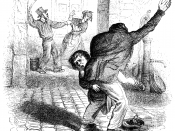While the word 'crisis' brings to mind events like September 11 or the Anthrax issue, 'crisis' could simply be a label attached to "a particular set of social circumstances, trying to draw attention to the fact that something out of the ordinary is happening, taking us away from a desirable state of affairs" (McConnell, 2003: 393). Domestic violence against women can be thought of such an issue that does indeed take us away from desirable state of affairs. In a 1998 South Australian study that interviewed 3001 people, eighteen percent reported that they had experienced some form of domestic violence. Of this eighteen percent, 66% were women and 34% were men. While this statistic is alarming in its own right, the number of women hurt due to physical abuse was 50.5%, as opposed to only 16.5% of men (Bagshaw, Chung, 2000: 3 - 13). These, as well as statistical findings by a number of studies, illustrate that violence against women is a serious and widespread problem, and requires strong commitment from both the government and society .
The women's liberation movement in the 1970s resulted in a national conference, outlining political demands based around childcare, abortion rights, equal work and pay rights and end of sexism. This can be seen as the beginning of an active political quest to end domestic violence in Australia (Bagshaw, Chung, 2000: 1; Porter, 2002: 381 ) In 1983, under Prime Minister Hawke, a policy advisory agency, the Office for the Status for Women (OSW), within the Prime Minister's Department was established in place of Adviser to the Prime Minister in Women's Affairs, and continues to exist to date (Porter, 2002: 389). We will examine previous and ongoing policy towards addressing the issue. However, in doing so, we will use an analytical tool, the policy...



Policy Monitoring Report
Good paper all around. You use a good number of citations to support your thoughts which are nicely written. Nice job.
4 out of 4 people found this comment useful.